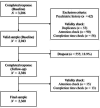Prospective investigation of positive psychotic symptoms, dissociative symptoms, and metacognitive dysfunctions in a non-clinical population
- PMID: 41083538
- PMCID: PMC12518616
- DOI: 10.1038/s41598-025-19547-w
Prospective investigation of positive psychotic symptoms, dissociative symptoms, and metacognitive dysfunctions in a non-clinical population
Abstract
The frequent co-occurrence of positive psychotic and dissociative symptoms in both clinical and non-clinical populations underscores the importance of understanding their interplay for early intervention. However, their longitudinal dynamics and shared risk factors in non-clinical individuals are poorly understood. This prospective study investigated the reciprocal relationship between positive psychotic and dissociative symptoms and the role of metacognitive dysfunction in 2,360 adults without psychiatric diagnoses (age 18-65). Participants completed online questionnaires at baseline and at six months, reporting levels of positive psychotic and dissociative symptoms, maladaptive metacognitive beliefs and metacognitive functioning. Longitudinal structural equation modelling, controlling for autoregressive effects, assessed the variables' cross-lagged associations. Results showed that baseline positive psychotic symptoms predicted dissociative symptoms at six months, and vice versa. Maladaptive metacognitive beliefs (lower cognitive self-consciousness) and poorer metacognitive functioning (self-reflectivity) at baseline predicted increased dissociative symptoms, but not positive psychotic symptoms, at six months. Higher baseline dissociative symptoms reciprocally predicted poorer metacognitive functioning at six months. Our findings support the mutual influence between positive psychotic and dissociative symptoms, and the specific association of metacognitive factors with dissociative symptoms, independent of co-occurring positive psychotic symptoms. Future research should extend these findings with longer follow-up periods and in clinically diverse groups.
Keywords: Cross-lagged panel model; Dissociation; Metacognition; Psychosis; Psychotic experiences; Structural equation modelling.
© 2025. The Author(s).
Conflict of interest statement
Declarations. Competing interests: The authors declare no competing interests.
Figures




References
-
- American Psychiatric Association. Diagnostic and Statistical Manual of Mental Disorders (American Psychiatric Association, 2013).
-
- Haugen, M. C. & Castillo, R. J. Unrecognized dissociation in psychotic outpatients and implications of ethnicity. J. Nerv. Mental Disease. 187, 751–754. 10.1097/00005053-199912000-00007 (1999). - PubMed
-
- Moise, J. & Leichner, P. Prevalence of dissociative symptoms and disorders within an adult outpatient population with schizophrenia. Dissociation9, 190–196 (1996).
MeSH terms
Grants and funding
LinkOut - more resources
Full Text Sources
Medical

